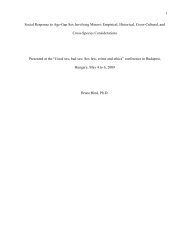Infant and Child Sexuality: A Sociological Perspective - Ipce
Infant and Child Sexuality: A Sociological Perspective - Ipce
Infant and Child Sexuality: A Sociological Perspective - Ipce
Create successful ePaper yourself
Turn your PDF publications into a flip-book with our unique Google optimized e-Paper software.
<strong>and</strong> differentiating adults by such words as “lady” or “man” are among<br />
these achievements. (Gesell <strong>and</strong> Ilg, 1946, p. 322).<br />
At two <strong>and</strong> one-half years of age the infant has added still more to<br />
his underst<strong>and</strong>ing of the socio-sexual scene. His differentiation of<br />
male <strong>and</strong> female roles has increased markedly. He is aware of his gender<br />
<strong>and</strong> the fact that he is like his parent of the same gender <strong>and</strong> different<br />
from his opposite-gender parent, as well as his opposite-gender<br />
peers. He can now differentiate the gender of children by the terms boy<br />
<strong>and</strong> girl. The two <strong>and</strong> one-half year old may well have incorporated a<br />
non-verbal generalization that boys <strong>and</strong> fathers have distinct genitalia<br />
<strong>and</strong> st<strong>and</strong> when they urinate while girls <strong>and</strong> mothers do not. This<br />
age marks the beginning of interest in the physiological differences<br />
between sexes. The infant is very conscious of his own sex organs <strong>and</strong><br />
may h<strong>and</strong>le them when undressed. Inquiries concerning mothers’ breasts<br />
are common. All in all, the infant has reached a point where, because<br />
gender distinctions are possible, socialization into a male or female<br />
role can <strong>and</strong> does occur. (Gesell <strong>and</strong> Ilg, 1946, p. 322; Ilg <strong>and</strong> Ames,<br />
1955, p. 203).<br />
Toward the end of infancy, or early in childhood, erotic feelings<br />
become centered in the genitalia <strong>and</strong> definite periods of sex play can<br />
be observed. (Ribble, 1955, p. 26). Sex interest increases with age <strong>and</strong><br />
is variable in that some infants <strong>and</strong> children are much more interested<br />
than other infants in the whole subject of sex. There are the highly<br />
motivated who show an early <strong>and</strong> intense interest in trying things out<br />
for themselves but ask few questions as well as those who are less interested<br />
in activity <strong>and</strong> more interested in asking questions about sex.<br />
There are others who are disinterested in the topic of sex.<br />
The infant shows a distinct sexual nature <strong>and</strong> develops a great deal<br />
in the first two years. Whatever the means, whatever the extent of curiosity,<br />
<strong>and</strong> whatever the restrictive or permissive forces, the infant<br />
of 0-2 years acquires sexual experience, knowledge, attitudes, <strong>and</strong><br />
feelings that may influence his whole life.<br />
The Sexual Capacity of <strong>Infant</strong>s<br />
Before specifically discussing the affectional <strong>and</strong> sexual behavior<br />
of infants, we will more systematically <strong>and</strong> conclusively establish that<br />
infants have the somato-sensory capacity for erotic behavior.<br />
Boy babies are sometimes born with erections, <strong>and</strong> there is no reason<br />
to believe that the capacity for such marked physiological response<br />
develops any later in girls. In a study of nine male babies of<br />
ages three to twenty weeks, tumescence (penile erection) was observed<br />
at least once daily in seven of the nine. (Halverson, 1940). Individual<br />
responses varied greatly from five to forty erections per day. Tumescence<br />
was accompanied in a large percentage of instances by<br />
restlessness, fretting, crying, stretching, <strong>and</strong> flexing the limbs<br />
stiffly. The behavior following the detumescence was in the nature of<br />
playful activity or relaxation. Parents often report having observed<br />
erections in infant boys. (Conn, 1940a).<br />
Pelvic thrust movements in male <strong>and</strong> female infants eight to ten<br />
months old appear to occur as part of an expression of affection in<br />
6
















